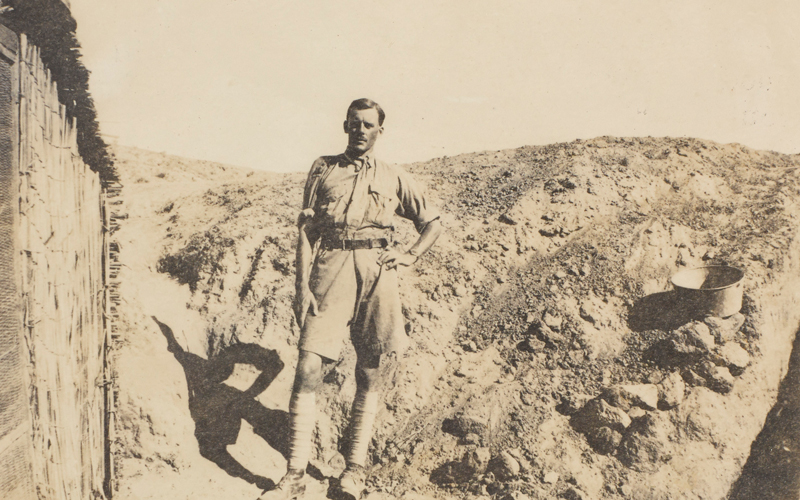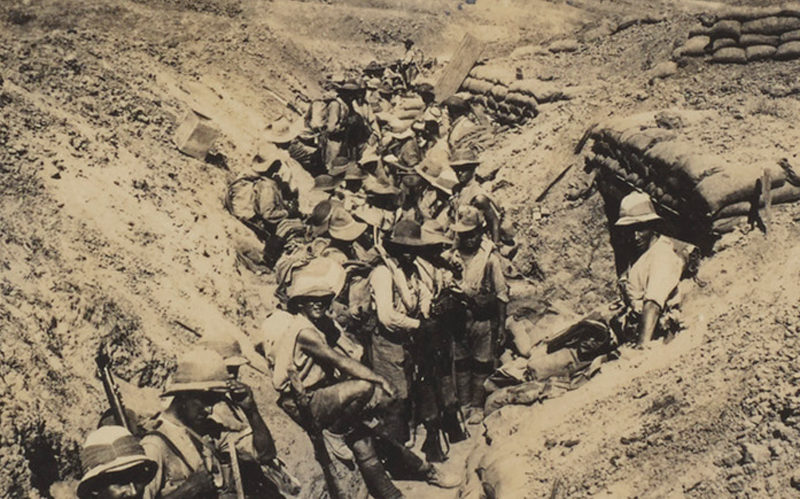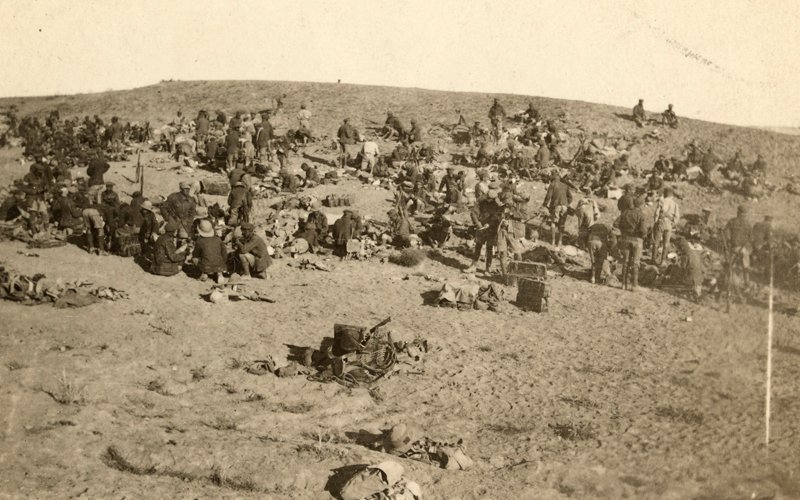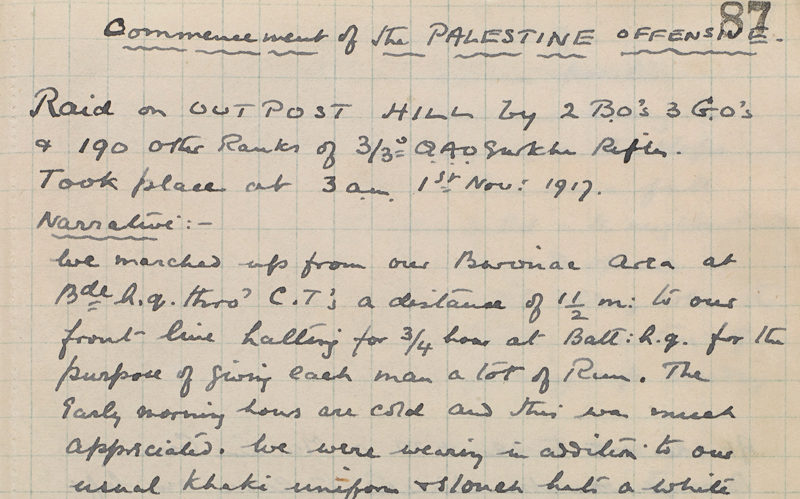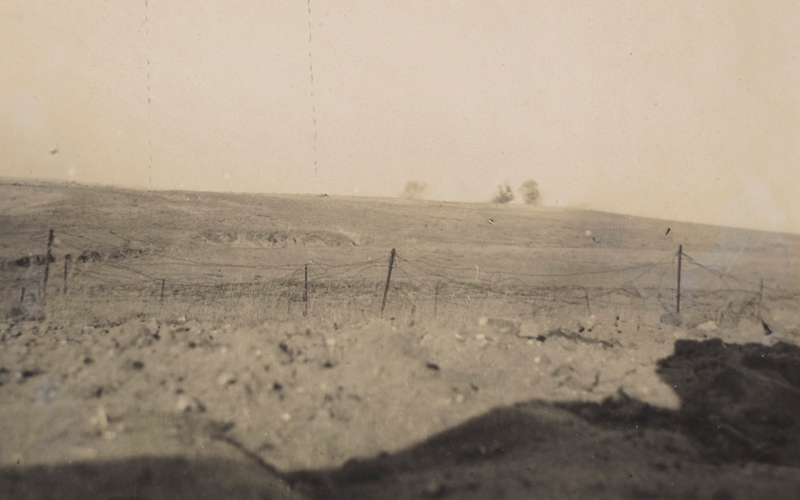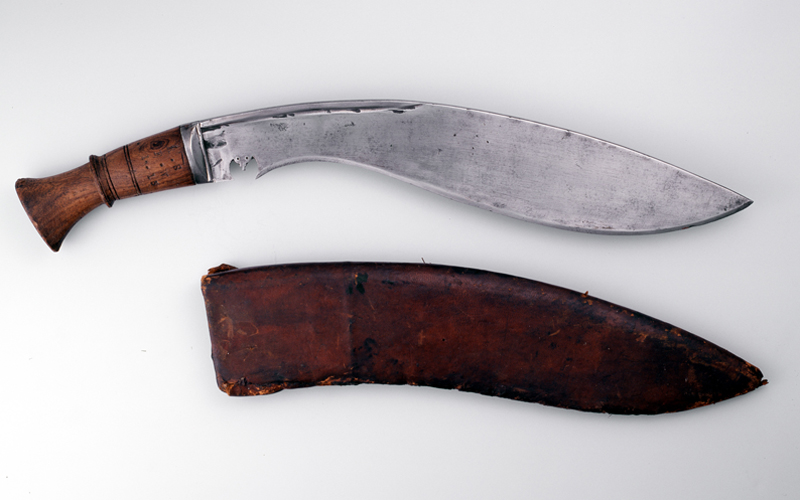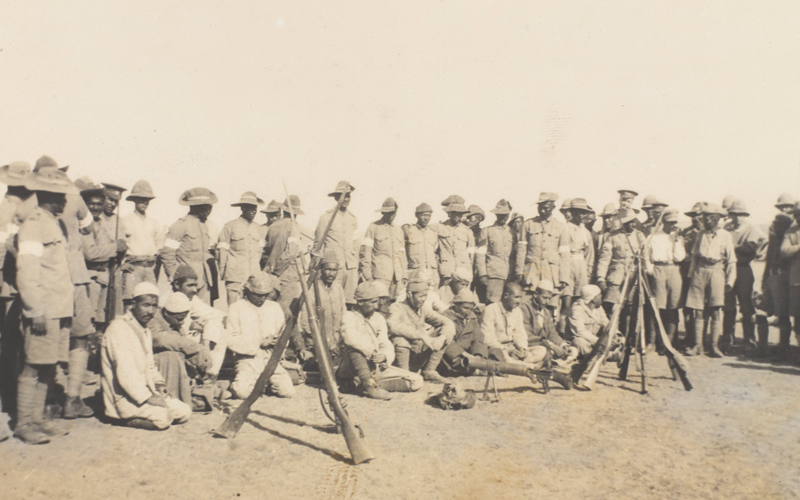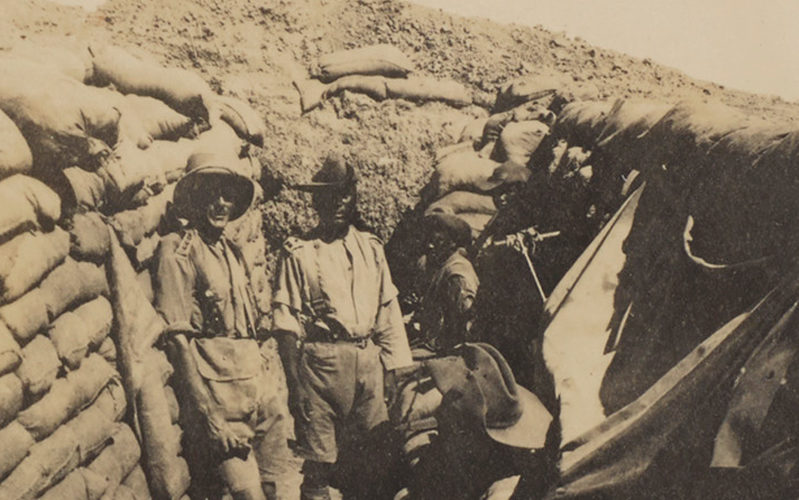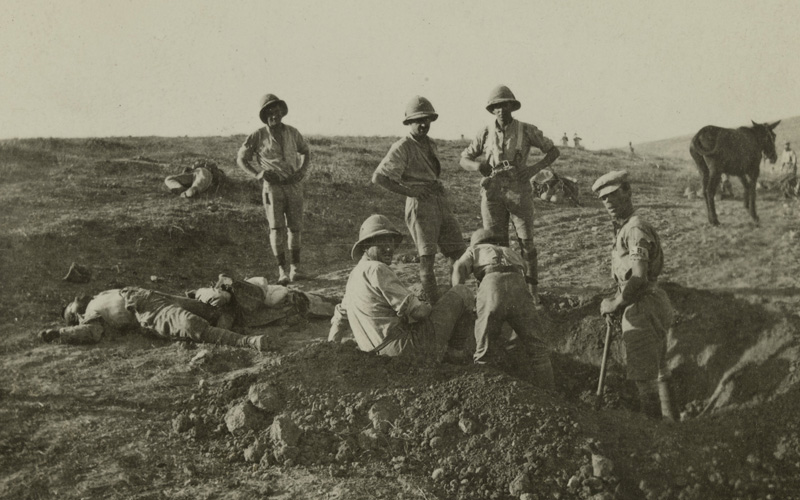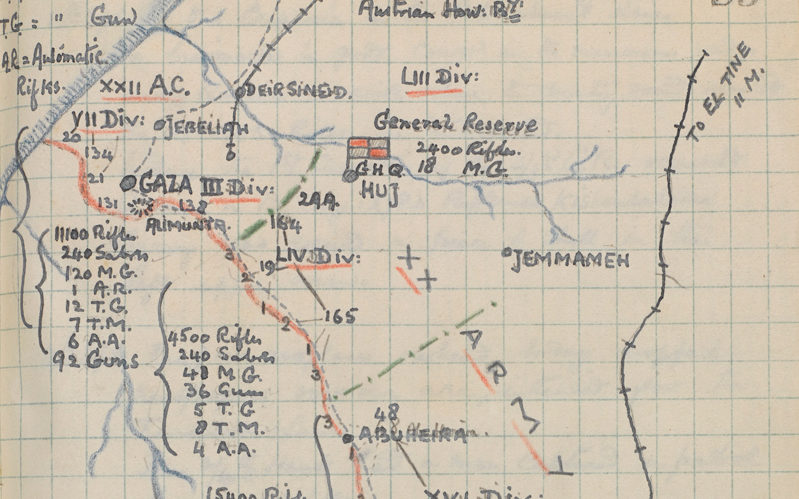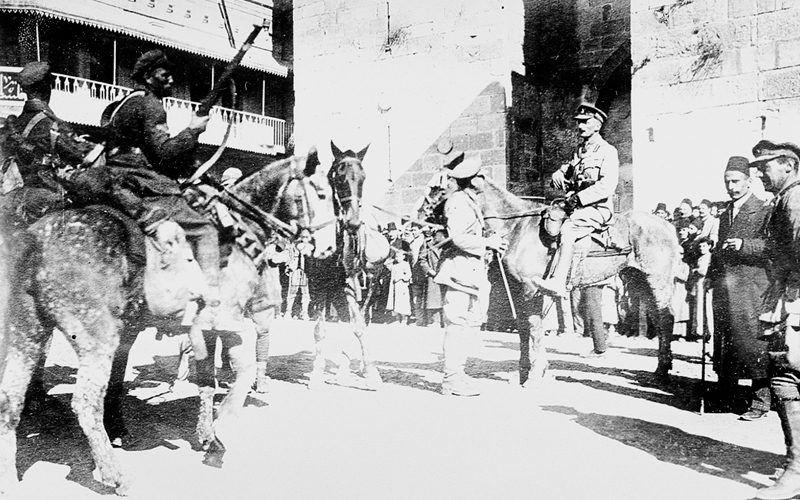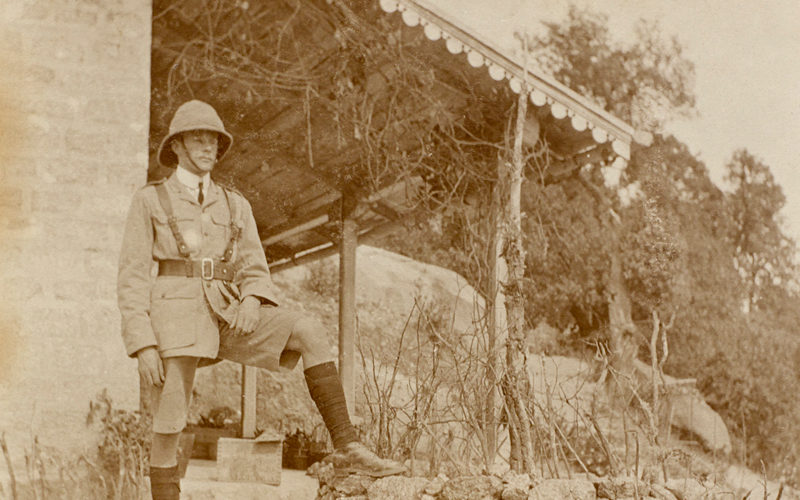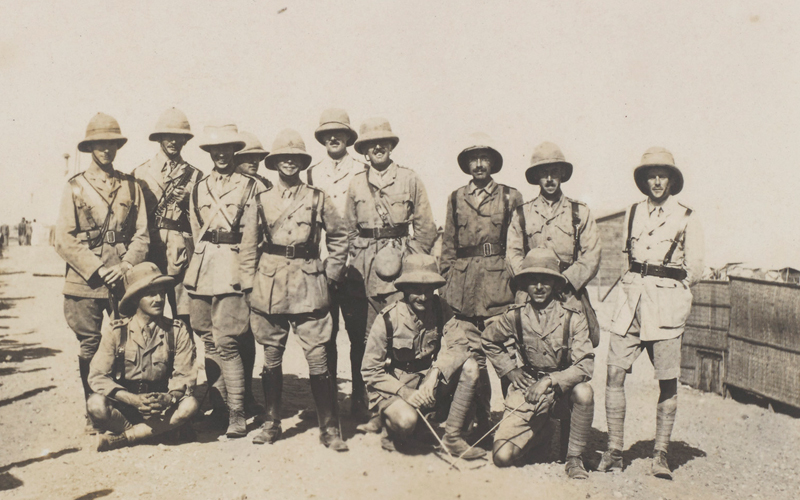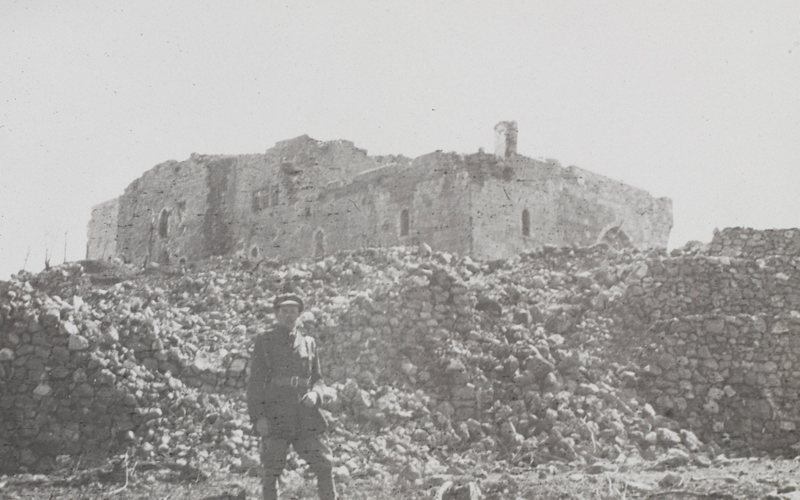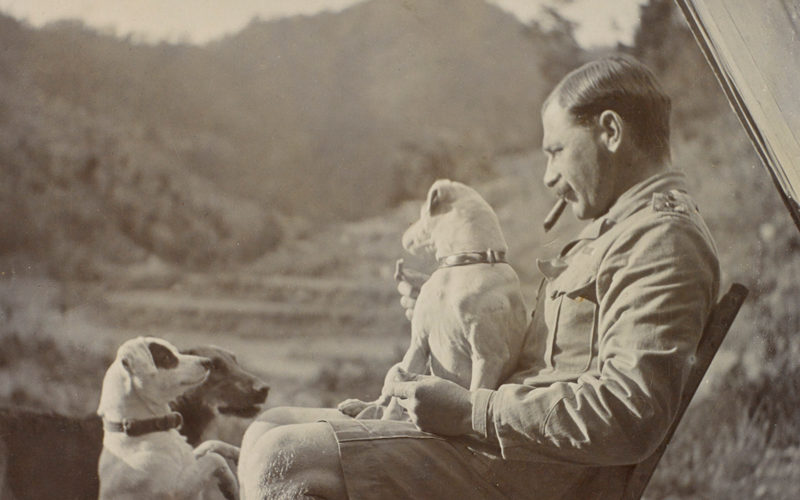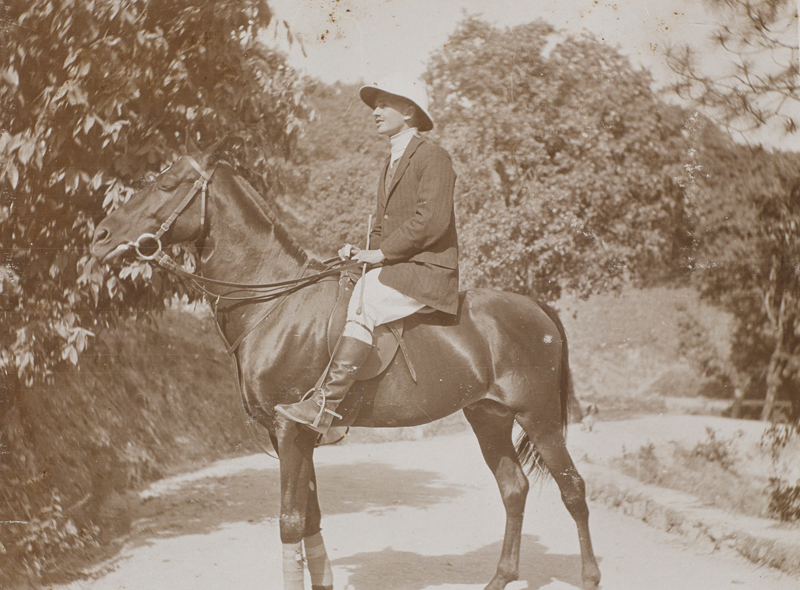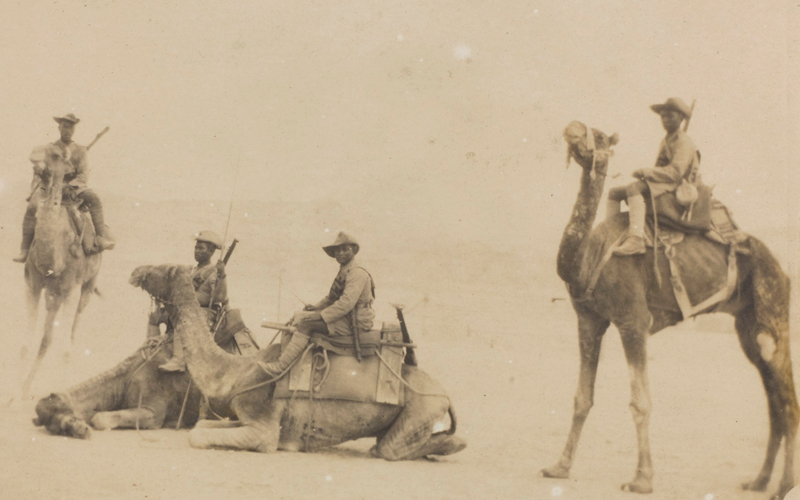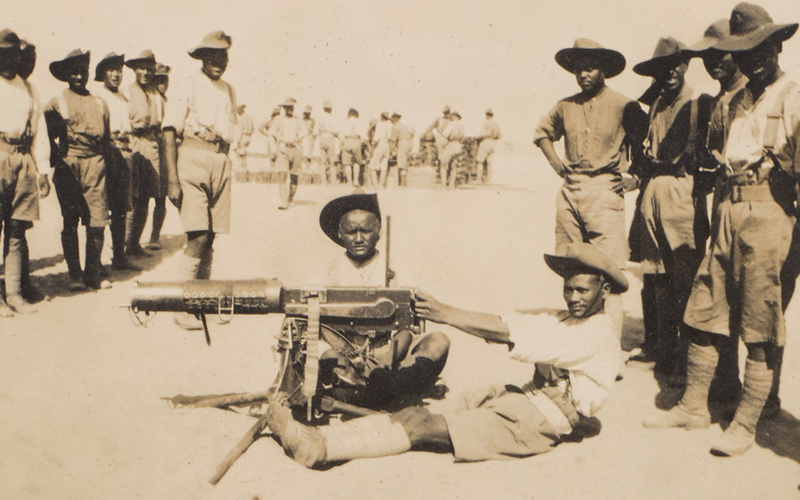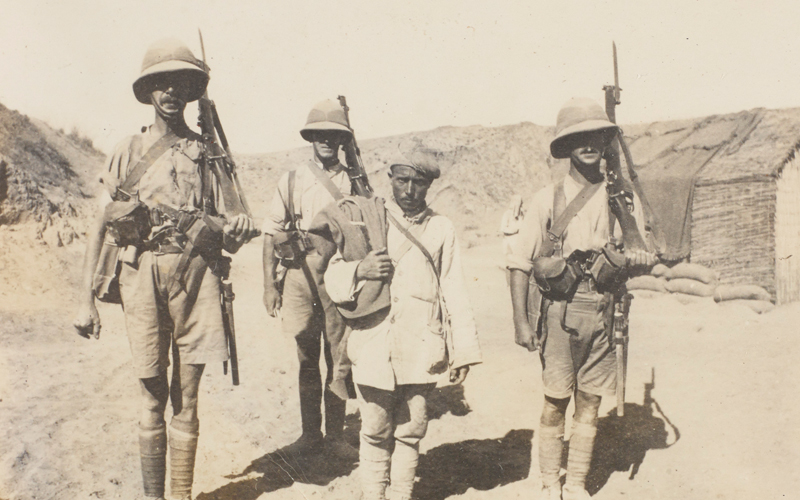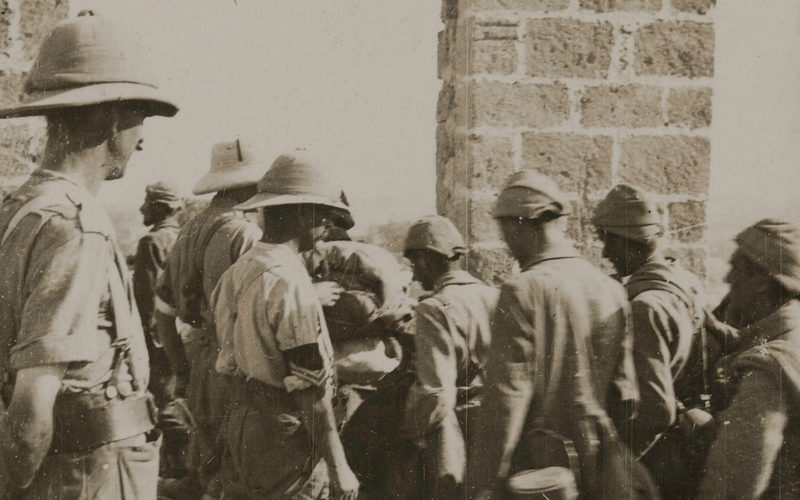The Third Battle of Gaza in November 1917 marked the beginning of the successful British campaign to conquer Palestine. One of those involved was Captain Walter Bagot-Chester, who won the Military Cross (MC) for his contribution. Bagot-Chester’s unpublished war diary and photographs offer us a unique eyewitness account of this bitter desert struggle. They also highlight the fighting prowess of the Gurkha soldiers he commanded.
Checked at Gaza
In January 1917 British Empire forces, under Lieutenant-General Sir Archibald Murray, advanced across the Sinai desert, having constructed a supply railway and a water pipeline.
Murray’s objective was Palestine, but although he beat the Turks at the Battle of Rafa (9 January 1917), two unsuccessful attacks on Gaza in March and April 1917 saw him replaced as commander by General Sir Edmund Allenby in June.
British officers and men of 3/3rd Queen Alexandra’s Own Gurkha Rifles in a front line trench, 1917
More details: NAM. 1960-12-337-2-144
Arab Revolt
Allenby brought a greater vigour to the Egyptian Expeditionary Force. But, more importantly, he brought reinforcements at a time when Turkish strength was being whittled away by the Arab Revolt. This had started the previous June and partly through the efforts of Colonel TE Lawrence – better known as ‘Lawrence of Arabia’, was helping to undermine Turkish strength.
By October 1917 the British out numbered the Turks by two to one in infantry and eight to one in cavalry, in one of the few theatres of war where mounted troops could still be used effectively.
Advance on Gaza
To wrong-foot the Turks Allenby now made a feint towards the heavily defended Gaza sector before launching his main attack further east against Beersheba (31 October 1917) on the northern edge of Sinai. Allenby’s British Yeomanry, Australian and Indian cavalry units were particularly successful.
The capture of Beersheba outflanked the Turks who were forced to retreat. The Third Battle of Gaza (1-2 November) then began and on 7 November 1917 Allenby entered the town.
More details: NAM. 1960-12-337-2-174
Raiding
As part of Allenby’s testing of the Gaza defences, the 75th Division, which included Bagot-Chester’s unit, 3rd Battalion The 3rd Queen Alexandra’s Own Gurkha Rifles, was tasked with aggressive raiding of the enemy lines.
Such raids, allied with regular bombardments, kept Turkish attention fixed on the Gaza front, while the developing threat to their east went unnoticed.
Troops resting after first two days of the Third Battle of Gaza, near Tira, 2 November 1917
More details: NAM. 2002-05-1-125
Outpost Hill
On the night of 31 October, Walter and 197 men from the 3rd Battalion were ordered to raid Outpost Hill, part of a chain of redoubts and fortifications.
After ‘giving each man a tot of rum’ to ward off the early morning cold, the troops gathered at Penton’s Gully. At 2.45am heavy howitzers opened fire on the enemy trenches.
‘The first dozen shells pitched correctly, the last 4 or 5 landed actually behind us and close to us between Penton’s Gully and our own firing line… We had one man wounded by them.’
The Gurkhas then moved to take up a position parallel with their objective. This meant leaving the cover of the wadi and lining up on the slopes leading to Outpost Hill.
‘There was a full moon… A Turkish patrol in the neighbourhood of the Burnt Tank saw us and opened a heavy fire which lasted until zero hour, when the barrage started. The men took no notice of this fire and continued forming up.’
More details: NAM. 1960-12-337-2-1
Barrage
At zero hour, 3am, the creeping barrage of 18-pounders started. Walter and his men advanced so well that they caught up with their own artillery fire. The guns, which should have been firing on Middlesex Hill and the Maze, were actually dropping some of their shells 50 or 100 yards short of the Turkish wire.
‘They were falling amongst us, but in spite of this the men carried on a steady advance and we all arrived on the top of the hill at zero + 9 minutes, i.e. the moment when the barrage was timed to lift. We thus arrived 2 minutes sooner than we were timed to do.
‘We suffered a few casualties from our own barrage by following so close but had we not done so we should probably have suffered more as the Turks would have had time to man their trenches.’
Shell bursts on Outpost Hill, part of the Gaza defences, October 1917
More details: NAM. 1960-12-337-2-176
Good kukri work
‘A few Turks were caught outside their wire. One was seen rolling down our side of the enemy’s parapet with a Gurkha hanging on to the leg of his trousers. In the firing line a few Turks were found and killed – 2 were manning a Lewis Gun and of these one was killed by a slash in the face with a kukri and the other was made prisoner.
‘A number of Turks were met in the CTs [communication trenches] connecting the firing line… and some good kukri work took place there. In one CT 2 Turkish heads were seen cleanly separated from their bodies. From another CT a Turk was endeavouring to climb out on the top, he had practically reached the top with his head and trunk over the edge and his legs hanging down when a Gurkha coming round a bend in the trench saw him and reaching up with his kukri inflicted a severe wound on that portion of the Turk’s frame which presented the largest target, causing him to fall back into the trench and become a prisoner.’
Bayonets and bombs
‘At several points individual bayonet encounters took place, invariably in our favour. One man accounted for 3 Turks with whom he fought and another encountering 2 Turks in a CT bayoneted the first and kukried the second. The majority of the Turks were found taking shelter in some fairly deep dug outs in the support trench. These were systematically bombed and the occupants were either killed by the explosions or kukried as they emerged. A few were taken prisoner.
‘Our stay in the enemy’s trenches lasted about 10 minutes when we returned by the same route by which we went out, followed by rifle and MG fire, which mostly came from Middlesex Hill. Fortunately owing to the nature of the ground, this fire only caused us a trifling casualty or 2. By 3.40am the whole raiding party, with the exception of one man wounded and missing, was back in our trenches.’
Aftermath
The Turks suffered 21 killed and nine wounded, but Bagot-Chester believed ‘more were killed and wounded by bombs in the dug outs but owing to lack of time… these were not counted’. Casualties of the 3/3rd were two killed, three severely wounded and 22 slightly hurt. The raiders captured 18 prisoners and one machine gun.
Walter also noted:
‘After we had all got back to our trenches the Turks opened a fairly heavy fire on our trenches with pip squeaks and a few 5.9’s but did no damage. They didn’t seem to lay down any definite barrage but fired their shells promiscuously. [We received] telegrams of congratulations on the success of the show from GOC Brigade, GOC Division, Corps Commander and GHQ.’
Coolness and courage
Bagot-Chester was later awarded the MC for his exploits. His citation stated:
‘For conspicuous gallantry and devotion to duty. He led a successful raid on the enemy’s lines. He showed the greatest coolness and courage under heavy machine-gun fire, reached all his objectives, and carried out a skilful withdrawal when the operation was completed.’
Major-General Phillip Palin, commander of 75th Division, noted in his report of the raid:
‘This is the first fight the 3/3rd Gurkhas has taken part in and the success meant a great deal to them. The raiders were well trained by Captain Bagot-Chester, who showed great resource and skill when leading the raid.’
More details: NAM. 1960-12-337-2-116
Enemy retreat
Following the raid, Walter recorded in his diary on 2 November:
‘Beersheba was captured with 1500 prisoners and 16 guns. Our casualties 900… All night Turkish artillery bombarded our trenches. They seemed to have been deceived as to the true point of our attack… [At] midnight, and twice again after, the Turks made strong counter-attacks which in each case were repulsed with heavy losses to them.’
On to Gaza
British and Gurkha troops again attacked Outpost Hill and its adjacent positions on 6-7 November. Little opposition was encountered and, on these posts being captured, patrols discovered that the enemy was retiring. Bagot-Chester’s diary recorded that ‘the Turks had already bolted’.
Three lines of trenches were subsequently occupied and in the days that followed they continued to pursue the retreating Turks, who launched repeated counter-attacks. One, near El Arish Redoubt ‘was decimated by our barrage fire, MG and rifle’.
Walter wrote that ‘we are well on the way to Gaza itself and the cavalry are working round between Gaza and the sea’. The following day the 3/3rd Gurkha Rifles became the first unit of 75th Division to reach the outskirts of Gaza town.
Captain Walter Bagot-Chester’s sketch map of the front line near Gaza, 13 September 1917
More details: NAM. 1960-12-337-2-107
General Allenby also pressed on with his offensive and defeated the Ottomans at the Battle of Mughar Ridge on 13 November 1917, before capturing Jaffa three days later. His forces then pushed north and after another successful offensive entered Jerusalem on 11 December 1917.
Biography
Walter Greville Bagot-Chester (1887-1918) was born on 15 March 1887 at Elford near Tamworth in Staffordshire. He was the son of Reverend Algernon Stewart McKenzie Bagot-Chester, rector of Elford, and Emily Mary Dillman Pyne.
After attending Sandhurst, Walter was commissioned into the Indian Army with the 3rd Queen Alexandra’s Own Gurkha Rifles in September 1908. He served with the 2nd Battalion and was promoted to lieutenant in December 1910.
On the outbreak of war in August 1914, the 2nd Battalion was stationed at Lansdowne cantonment in Garhwal, India. Following mobilisation it was despatched from Bombay to Europe with the 20th (Garhwal) Brigade, arriving in Marseilles on 12-14 October 1914.
Bagot-Chester was sent to France in advance as an embarkation officer ahead of their arrival. He later took part in the Defence of Festubert (23–24 November 1914) and Givenchy (20-22 December 1914), and the Battles of Neuve Chapelle (10-13 March 1915) and Aubers (9 May 1915), being Mentioned in Despatches on 23 July 1915.
In September 1915 he was promoted to captain. That month his battalion fought at the Battle of Loos (25 September-8 October 1915) where Walter was severely wounded. His right shoulder was shattered and he sustained six other injuries. After being hit, Walter and a wounded Gurkha had to lie for over 12 hours in a shell hole under heavy fire and pouring rain, until they could eventually creep back to British lines.
Bagot-Chester spent the next year recovering from his wounds, but he left Southampton for Egypt in October 1916 to rejoin his battalion. The 2/3rd had been in the Middle East since November 1915 helping defend the Suez Canal.
Walter was appointed battalion adjutant in December 1916 and in January 1917 he was transferred from the 2/3rd to the 3/3rd Gurkha Rifles, which was then being formed as a new battalion. This unit joined 233rd Brigade, and in June 1917 took over a section of the defences near Rafa in Palestine before joining the advance on Gaza in late October.
More details: NAM. 1960-12-337-2-84
Bagot-Chester was again wounded during a Turkish counter-attack at the Battle of Nebi Samwil near Jerusalem on 22-23 November 1917. He described the fighting in his diary:
‘At about 8am the Turks started shelling us, and so continued all day. The shelling was very heavy and came from 3 directions. Presently the Turks were to be seen advancing to the attack of our hill from an opposite ridge. They were met by heavy rifle fire from our side but they soon reached the bottom of the valley and were under cover of the dead ground of our hill up which they were now climbing showing themselves less frequently.
‘As time went on our ammunition began to get exhausted and our numbers considerably lessened owing to the continuous shellfire… Towards 12 noon we decided, owing to the thinned ranks, that we must hold on to the walled mosque alone as a keep… We put riflemen at the windows and got a couple of Maxim guns in the minaret… By doing this were rather asking the Turk to turn his heavy guns on to the mosque but it was only from the minaret windows that a good view could be obtained and where effective fire could be directed. We felt confident that we could hold on till dark or any hour until the situation became relieved by our attack developing on our right.
‘But at 1pm the Turks commenced shelling the mosque itself…. This they shelled systematically with intent to demolish the place altogether. We had about 50 wounded on stretchers inside and the poor fellows had a terrible time with stones falling all around them, any one of which was sufficient to kill a man… Shells continued to fall in the mosque, on the roof, against the walls… The whole place became full of brick dust so that from outside, so we were told, the mosque appeared on fire.
‘We could only pray for darkness… with it came the Turk who having approached close up under cover of the stone walls was able to mass for an assault. Our remaining small band of heroes consisting of HQ section with a few signallers, runners, scouts and the remains of A and B Companies counter-attacked. Ammunition was shared and recourse was had to sword, kukri and rocks with which the Turk was repulsed and driven out. A this critical moment relief came in the shape of a company or two of the Scottish Rifles who took over from us.’
Captain Bagot-Chester in the ruins of Nebi Samwil mosque where he was wounded in November 1917
More details: NAM. 1960-12-337-2-188
Five of the 3/3rd’s seven officers were casualties, including Bagot-Chester who was hit by shell and stone fragments. And 380 of 722 other ranks were killed, wounded or listed as missing. Bagot-Chester remained on duty, however, until 25 November 1917, when he was eventually evacuated to 66th Casualty Clearing Station at Bela.
Walter was then in the British Red Cross hospital at Giza until 26 January 1918 when he again rejoined his battalion, taking part in the advance north of Jerusalem.
Promoted to acting major, on 27 March he was wounded by shellfire at Hill 1263 near Mughair Ahmed while supervising the consolidation of a recently gained position. He died the following morning and was later buried at Ramleh War Cemetery. Lieutenant-Colonel Sidney Eastmead, his former commanding officer from 2nd Battalion, recalled:
‘In the death of Captain W. G. Bagot-Chester the battalion, and the regiment, lost an officer impossible to replace. It is difficult to express on paper what his presence meant to the battalion. He was certainly one of the very best regimental officers in the Indian Army. Severely wounded with the 2nd Battalion in France and wounded again with the 3/3rd at Nebi Samwell, his one idea was to get back with the battalion and his beloved D Company. The Gurkha ranks thought there was no one like him.’
Explore further
- Article: Other Soldier Stories
- Article: The Gurkhas
- Article: Battle of Megiddo
Explore the map for similar stories
Captain Walter Bagot-Chester - Elford, Staffordshire
 First World War in Focus
First World War in Focus